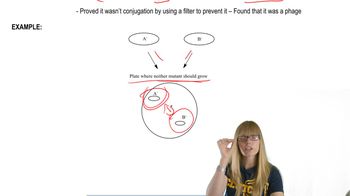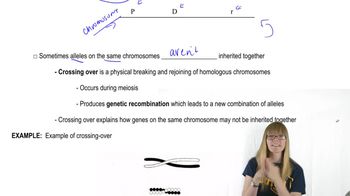Table of contents
- 1. Introduction to Genetics51m
- 2. Mendel's Laws of Inheritance3h 37m
- 3. Extensions to Mendelian Inheritance2h 41m
- 4. Genetic Mapping and Linkage2h 28m
- 5. Genetics of Bacteria and Viruses1h 21m
- 6. Chromosomal Variation1h 48m
- 7. DNA and Chromosome Structure56m
- 8. DNA Replication1h 10m
- 9. Mitosis and Meiosis1h 34m
- 10. Transcription1h 0m
- 11. Translation58m
- 12. Gene Regulation in Prokaryotes1h 19m
- 13. Gene Regulation in Eukaryotes44m
- 14. Genetic Control of Development44m
- 15. Genomes and Genomics1h 50m
- 16. Transposable Elements47m
- 17. Mutation, Repair, and Recombination1h 6m
- 18. Molecular Genetic Tools19m
- 19. Cancer Genetics29m
- 20. Quantitative Genetics1h 26m
- 21. Population Genetics50m
- 22. Evolutionary Genetics29m
5. Genetics of Bacteria and Viruses
Transduction
Problem 20a
Textbook Question
Textbook QuestionA triple-auxotrophic strain of E. coli having the genotype phe⁻ met⁻ ara⁻ is used as a recipient strain in a transduction experiment. The strain is unable to synthesize its own phenylalanine or methionine, and it carries a mutation that leaves it unable to utilize the sugar arabinose for growth. The recipient is crossed to a prototrophic strain with the genotype phe⁺ met⁺ ara⁺. The table below shows the selected marker and gives cotransduction frequencies for the unselected markers. Selected Selected Colonies Containing the Marker Unselected Marker (%) _ phe⁺ met⁺ ara⁺ met⁺ 4 - 7 phe⁺ - 2 51 met⁺, phe⁺. - - 79 ara⁺ 68 5 - Use the cotransduction data to determine the order of these genes.
 Verified Solution
Verified SolutionThis video solution was recommended by our tutors as helpful for the problem above
Video duration:
2mPlay a video:
Was this helpful?
Key Concepts
Here are the essential concepts you must grasp in order to answer the question correctly.
Transduction
Transduction is a process of genetic transfer in bacteria where bacteriophages (viruses that infect bacteria) transfer DNA from one bacterium to another. This mechanism can lead to genetic recombination and is crucial for understanding how traits can be passed between bacterial strains. In the context of the question, transduction is used to introduce genes from a prototrophic strain into a triple-auxotrophic E. coli strain.
Recommended video:
Guided course

Transduction
Cotransduction Frequency
Cotransduction frequency refers to the likelihood that two genes will be transferred together during the transduction process. This frequency can provide insights into the physical proximity of genes on a chromosome; genes that are closer together are more likely to be cotransduced. Analyzing cotransduction frequencies helps determine the relative order of genes based on how often they are co-inherited.
Recommended video:
Guided course

Transduction
Genetic Mapping
Genetic mapping is the process of determining the arrangement of genes on a chromosome. By using data such as cotransduction frequencies, researchers can infer the order of genes and their distances from one another. In this experiment, the cotransduction data will be analyzed to establish the sequence of the genes phe, met, and ara, which is essential for understanding their genetic linkage.
Recommended video:
Guided course

Mapping Overview
Related Videos
Related Practice



